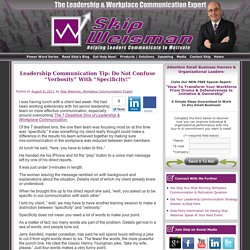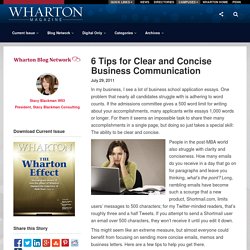

Albert Einstein. Speaking Clearly and Concisely. In our continued series to define Executive Presence more precisely, we now look at The Clarity of our Speaking.

We defined this skill as: Speaks clearly and concisely. Bottom lines without unnecessary story. At top levels, there is more and more bottom-lining and more facts, simply stated; less meandering story-telling and detail. There are lots of ways to look at speaking patterns and how to best understand the speaking and listening needs of our colleagues. “Story” people like to relay the details of the situation, they like to offer the context of the situation first, so that the end solution or question lives inside a bigger picture. “Point” people say the bottom line first, sometimes backing it up with detail or color. As you might imagine, we all like to hear others speak in our preferred way. The Fine Art Of Getting To The Point. Joseph McCormack thinks everything would be better if people could just get to the point.

As the author of Brief and founder of the Sheffield Company, a marketing firm that focuses on helping clients craft concise messaging, he’s observed first hand how endless meetings, data dumps, and wordy emails are becoming the bane of business. McCormack tells Fast Company this pain point comes from "the Four Is" a layered mix of irritants and impatience that add up to one permanent pain point: Information Inundation: Every day the average American consumes 34GB of content and checks their phone up to 150 times. Worker bees can get over 300 emails a week. Inattention: We only truly focus for six hours per week. Clear & Concise Communication. Do Not Confuse “Verbosity” With “Specificity!”
I was having lunch with a client last week.

We had been working extensively with his senior leadership team on more effective communication, especially around overcoming The 7 Deadliest Sins of Leadership & Workplace Communication. Of the 7 deadliest sins, the one their team was focusing most on at this time was “specificity.” It was something my client really thought could make a difference in the results his team achieved together by making sure mis-communication in the workplace was reduced between team members. At lunch he said, “here, you have to listen to this.” He handed me his IPhone and hit the “play” button to a voice mail message left by one of his direct reports. 5 Effective Communication Skills. Having effective communication skills is imperative for your success.

Positive communication will certainly increase the opportunities you find in your career and business. Having good communication skills will enable you to get ahead in certain areas where others who are less assertive may not succeed. A few things to keep your eyes on while practicing the fine art of communication are: Body Language Do not shy away from the person with whom you are speaking. 6 Tips for Clear and Concise Communication. In my business, I see a lot of business school application essays.

One problem that nearly all candidates struggle with is adhering to word counts. If the admissions committee gives a 500 word limit for writing about your accomplishments, many applicants write essays 1,000 words or longer. For them it seems an impossible task to share their many accomplishments in a single page, but doing so just takes a special skill: The ability to be clear and concise. People in the post-MBA world also struggle with clarity and conciseness. How many emails do you receive in a day that go on for paragraphs and leave you thinking, what’s the point? This might seem like an extreme measure, but almost everyone could benefit from focusing on sending more concise emails, memos and business letters. Lead with your main point: If you were forced to boil down your email to one or two sentences, what would they say? The 7 Cs of Communication Checklist.
Think of how often you communicate with people during the day. You write emails, facilitate meetings, participate in conference calls, create reports, devise presentations, debate with your colleagues… the list goes on. We can spend almost our entire day communicating. So, it stands to reason that communicating clearly and effectively can boost productivity. This is why the 7 Cs of Communication are helpful. The 7 Cs provide a checklist for making sure that your meetings, emails, conference calls, reports, and presentations are well constructed and clear – so your audience gets your message. According to the 7 Cs, communication needs to be: Clear. Characteristics of Good Communication. Start with purpose then communicate, communicate, communicate.
Ronan Dunne was appointed Chief Executive Officer of Telefónica UK in January 2008.

At this... Ronan Dunne was appointed Chief Executive Officer of Telefónica UK in January 2008. At this time, he also joined the board of Telefónica Europe plc. Ronan Dunne was previously Chief Financial Officer of Telefónica UK, a position held since February 2005. Before this, he held the role of Head of Finance, at parent company O2 plc, reporting to the Group Chief Financial Officer. Ronan is a fellow and former council member of the Institute of Chartered Accountants in Ireland (ICAI). Ronan spoke at LeadersIn Business on November the 8th. More information: www.o2.co.uk.